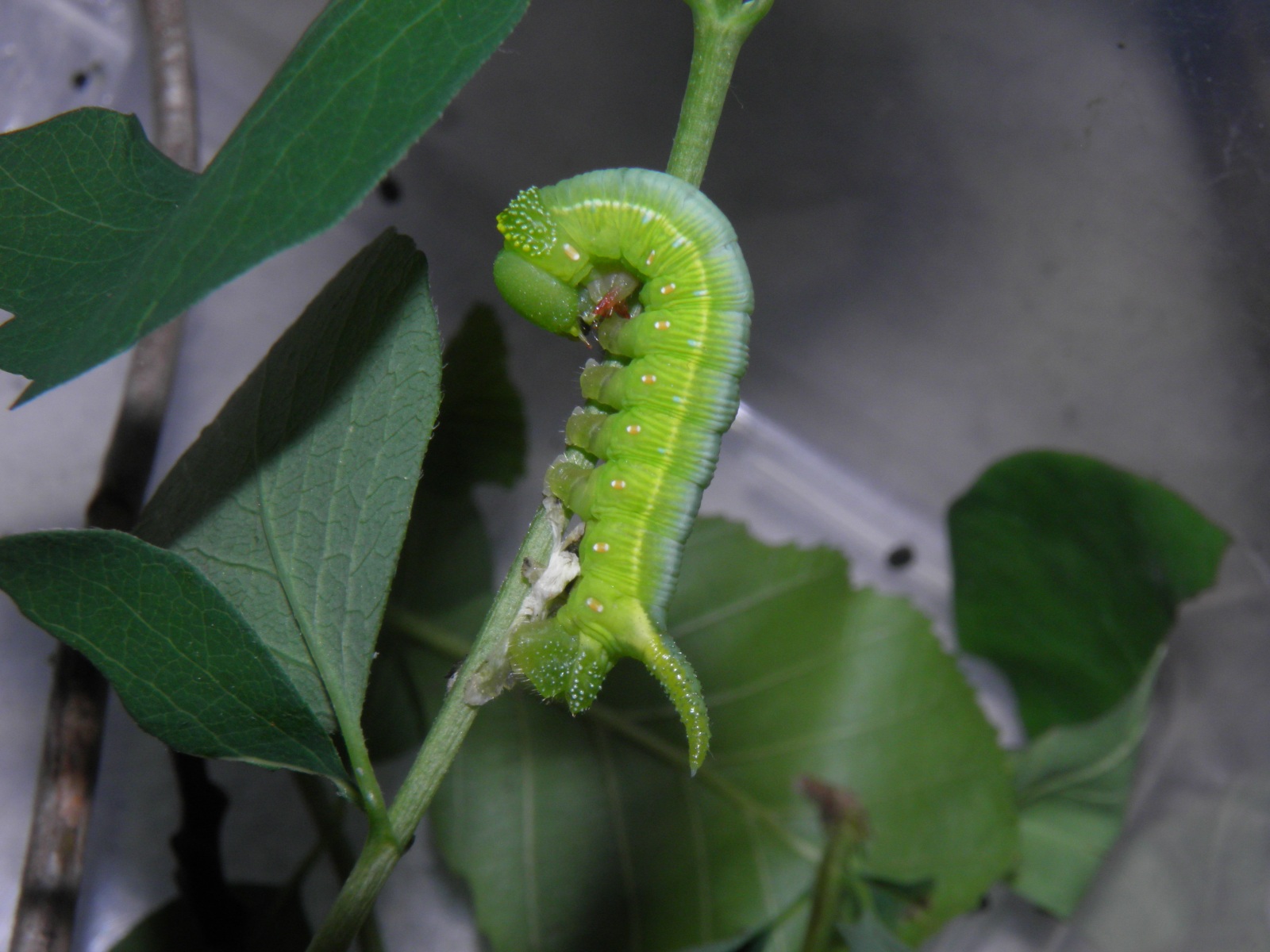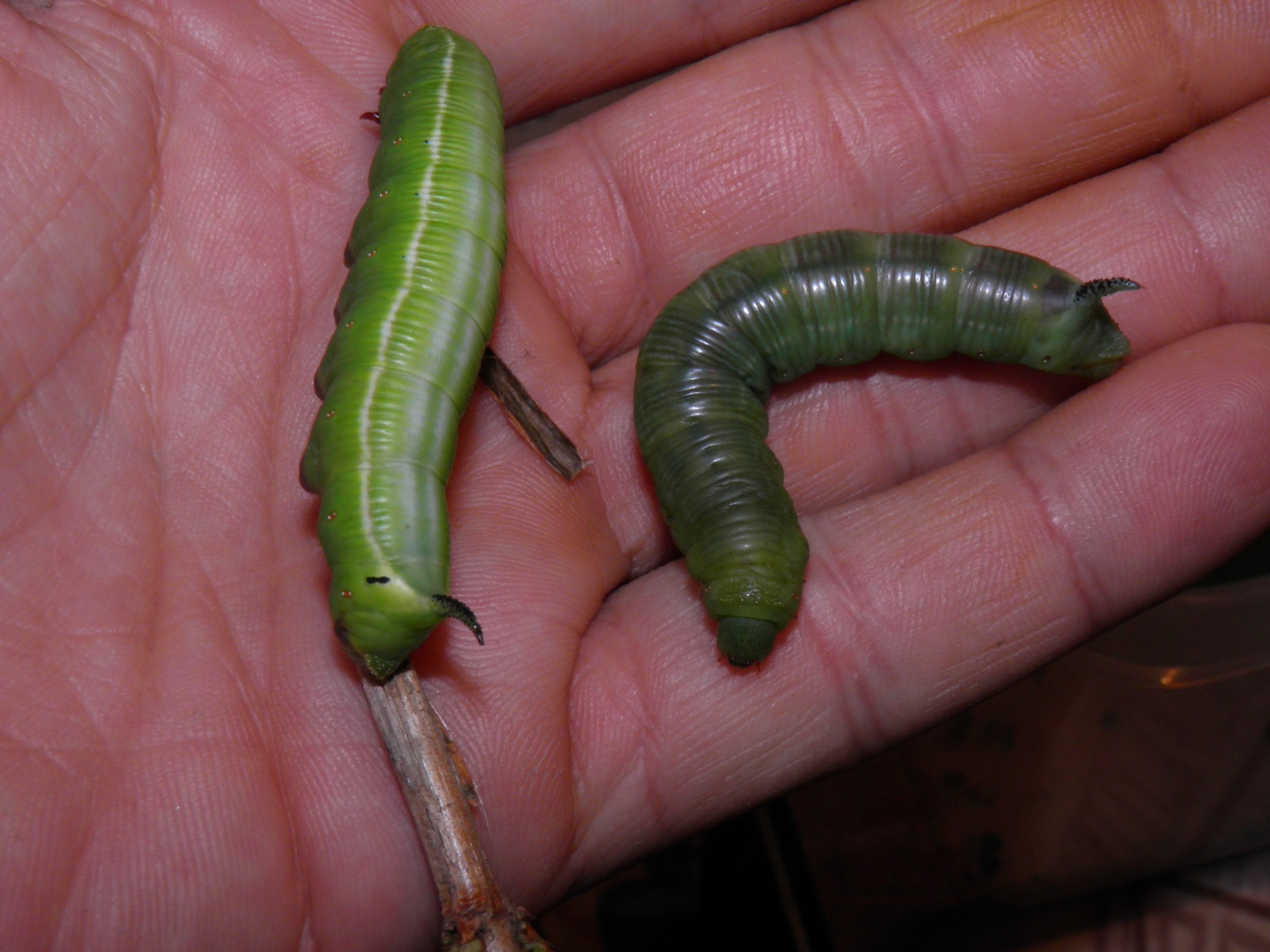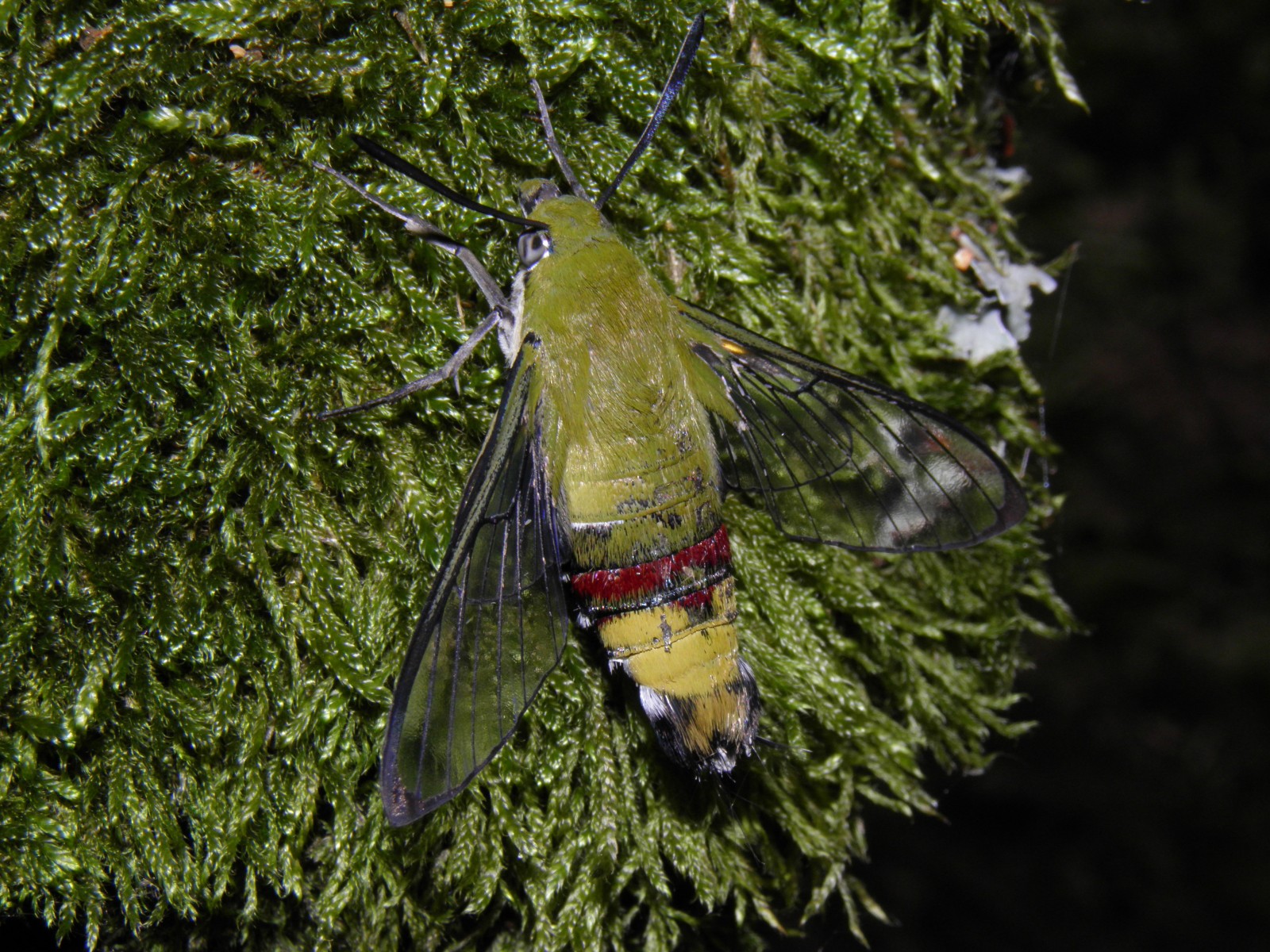Cephonodes hylas, known as the ‘coffeebean hawkmoth’ or ‘pellucid hawkmoth’, is a type of clear winged hummingbird hawkmoth (Macroglossinae) with a large distribution found throughout the warmer parts of the Middle East, Asia and Africa. The caterpillars mainly feed from a wide range of Rubiaceae plants, including but not limited to Adina sp., Guettarda speciosa, Pavetta mollissima, Haldina, Mitragyna, Mussaenda, Morelia senegalensis, Canthium odoratum. Randia, Catunaregam, Wendlandia, Ixora and Kraussia lanceolata – the list includes a few plants host of (agri)cultural value such as Gardenia, and Coffea (coffee). For this reason they are also encountered in suburban habitats, where the adults are famously seen visiting flowers in gardens and parks. The moths are day active and rest at night. Much like most members of the hummingbird hawkmoth subfamily, the adult moths can beat their wings in a very rapid fashion and appear to float in a hummingbird like way; they are able to hover, make sudden and sharp turns and can even fly backwards. They feed from flowers in mid-air by hovering above them and extending their proboscis to access the nectar. It has been reported that larvae also feed from a few kinds of non-Rubiaceae plants; such as Ervatamia angustisepala (Apocynaceae), Lonicera (Caprifoliaceae) – and suprisingly Ligustrum sp. (Olaceae) is another food plant it has been recorded on on the wild. It is unclear if privet (Ligustrum sp.) is a ‘true’ host plant utilised in the wild or simply a substitute host plant, since it is a convient food plant commonly used by hobbyists in the hobby moth breeding scene. The larvae can be raised on it from egg to adult, however.
Depending on the geographical location they seem to have one to several generations a year; it mainly depends on if the local climate allows it or not. In the tropical regions, they are most likely nearly continuously brooded, producing two to four generations in one year. The pupae, however, can overwinter, which is exactly what they do in more temperate climates, where they can survive mild to colder winters, including snowfall and frost. Fully grown larvae do not burrow underground to pupate like most Sphingidae; instead, they are one of the few Sphingidae species that can spin a cocoon. However, unlike the cocoons of many types of silkmoths, the exterior of Cephonodes hylas cocoons is not just made of silk; they heavily rely on leaf litter, twigs, earth and dirt that they spin together with silk. These cocoons are produced in the foliage of the host plants, in leaf litter on the floor or in narrow crevices.
 Cephonodes hylas, adult – when freshly emerged, the wings still have scales that fall off after the first (=maiden) flight.
Cephonodes hylas, adult – when freshly emerged, the wings still have scales that fall off after the first (=maiden) flight.
- Difficulty rating: Average (Not too hard to breed)
- Rearing difficulty: 5/10 (From egg to pupa)
- Pairing difficulty: 6.5/10 (Archieving copulations)
- Host plants: Generally prefers various Rubiaceae plants, but also plants from other families. Examples of recorded food plants include Coffee (Coffea sp.), Gardenia (Gardenia jasminoides), Snowberry (Symphoricarpos sp.), Privet (Ligustrum sp.) Honeysuckle (Lonicera sp.), Buttonbush (Cephalanthus occidentalis), Adina sp., Guettarda speciosa, Pavetta mollissima, Haldina, Mitragyna, Mussaenda, Morelia senegalensis, Canthium odoratum, Randia, Catunaregam, Wendlandia, Ixora, Tricalysia dubia, Kraussia lanceolata, Ervatamia angustisepala and quite likely many, many more.
- Natural range: Has a very wide range; large parts of Africa, Australia and Asia including but not limited to Angola, Benin, Burkina Fasso, Cameroon, Central African Republic, Chad, Comoros, Congo, DRCongo, Djibouti, Eritrea, Ethiopia, Gabon, Gambia, Ghana, Guinea, Ivory Coast, Kenya, La Reunion, Madagascar, Malawi, Mozambique, Namibia, Nigeria, Rwanda, Senegal, Sierra Leone, Somalia, South Africa, Sudan, Tanzania, Uganda, Zambia, Zimbabwe, Pakistan, possibly, but not well confirmed in a very small part of Russia
- Polyphagous: Yes, but prefers a wide variety of (sub)tropical genera of Rubiaceae plants; has also been recorded on a few kinds of plants from other families such as Olaceae, Caprifoliaceae, Apocynaceae
- Generations: Multivoltine – can have several generations
- Family: Sphingidae (hawkmoths)
- Pupation: Subterranean (burrows in soil)
- Prefered climate: Subtropical / tropical; found in the hotter and more humid kind of environments, but can survive colder winters with snowfall and frost in some localities.
- Special notes: Hatchling larvae are very small; be careful not to lose them! Put them on a potted plant or in a sleeve so you do not have to change them until they are big enough to see for the naked eye, or use a magnifier.
- Wingspan: 40mm – 65mm
- Binomial name: Cephonodes hylas (Linnaeus, 1771)
Adults of Cephonodes hylas deposit their eggs directly on their respective host plants, one or few eggs at a time. The eggs of Cephonodes hylas are very small, oval, pale and translucent. They hatch extremely fast; so fast, that transporting them by mail is impossible in most cases. The eggs of Cephonodes hylas hatch in just 3 to 6 days time, depending on the temperature. Do not be suprised to find larvae in just 3 days time in warm summer days! In captivity the caterpillars will feed on many types of Rubiaceae – commonly used to raise them are Gardenia, Lonicera, Symphoricarpos, Coffea, Ligustrum and Cephalanthus.
The first two instars are very small and pale; first instar larvae tend to have a habit of gnawing holes from the middle of the leaf instead of from the edge, while resting on a leaf vein in order to camouflage themselves well. Larvae can be well hidden in budding leaves or on leaf veins, revealing themselves only by the frass and holes bitten into these leaves. If one wishes to raise them in captivity, a tip is to create a setup that does not need cleaning for 10 to 15 days time – this gives larvae time to grow and become more visible to the naked eye, eliminating the risk of throwing some away by accident if cleaning the old leaves. This can be archieved with potted plants or plant cuttings in a water source that keeps them hydrated.
 Cephonodes hylas L1 (first instar)
Cephonodes hylas L1 (first instar)
 Cephonodes hylas second instar (L2)
Cephonodes hylas second instar (L2)
From the third instar and beyond larvae get more noticable spiracula and anal horns, and a bumpy/warty patch in their ‘neck’ (connecting the head capsule and first thoraric segment) and start become less ‘shy’ in their behaviour and feeding habits.
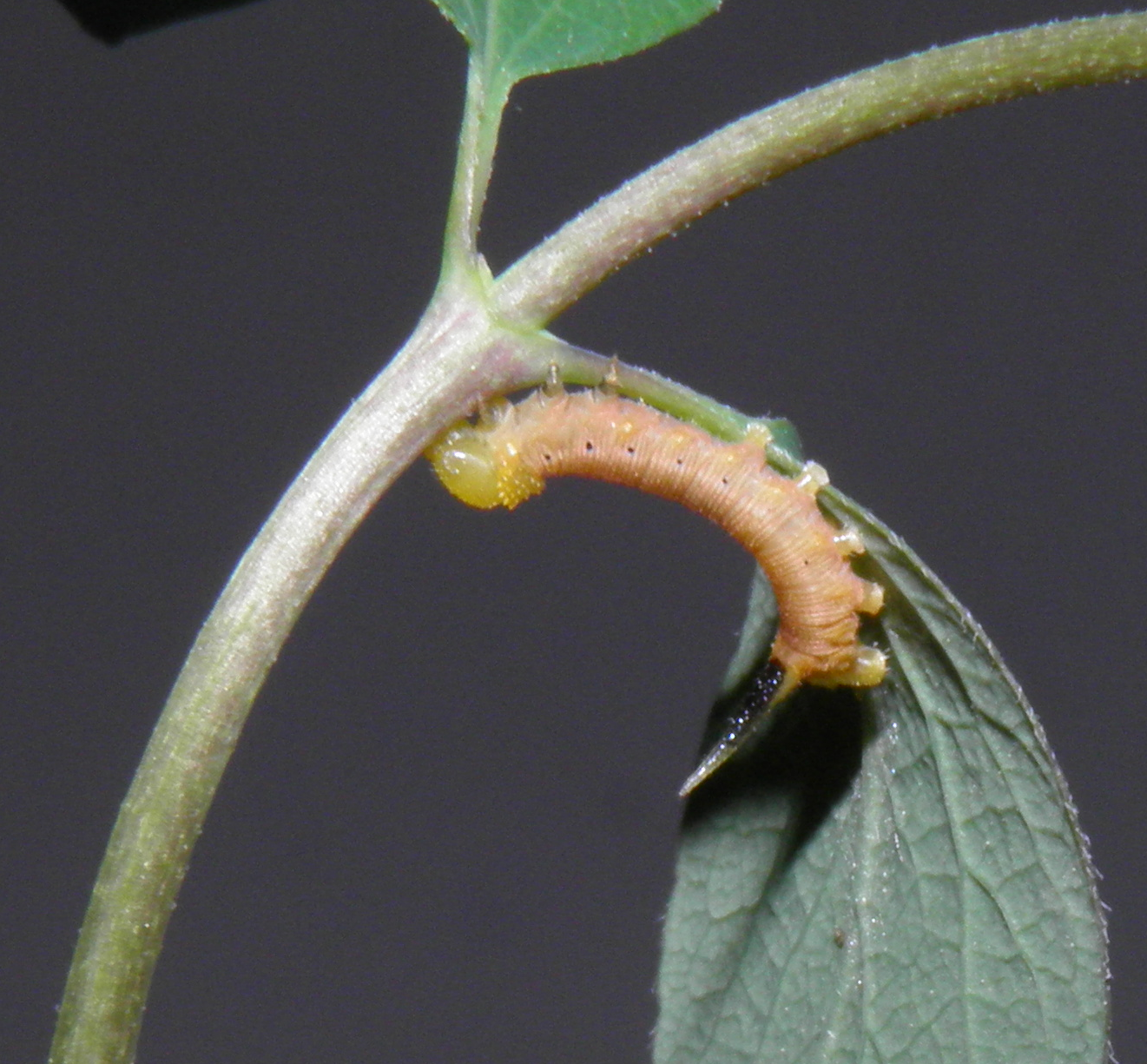 Cephonodes hylas third instar (L3)
Cephonodes hylas third instar (L3)
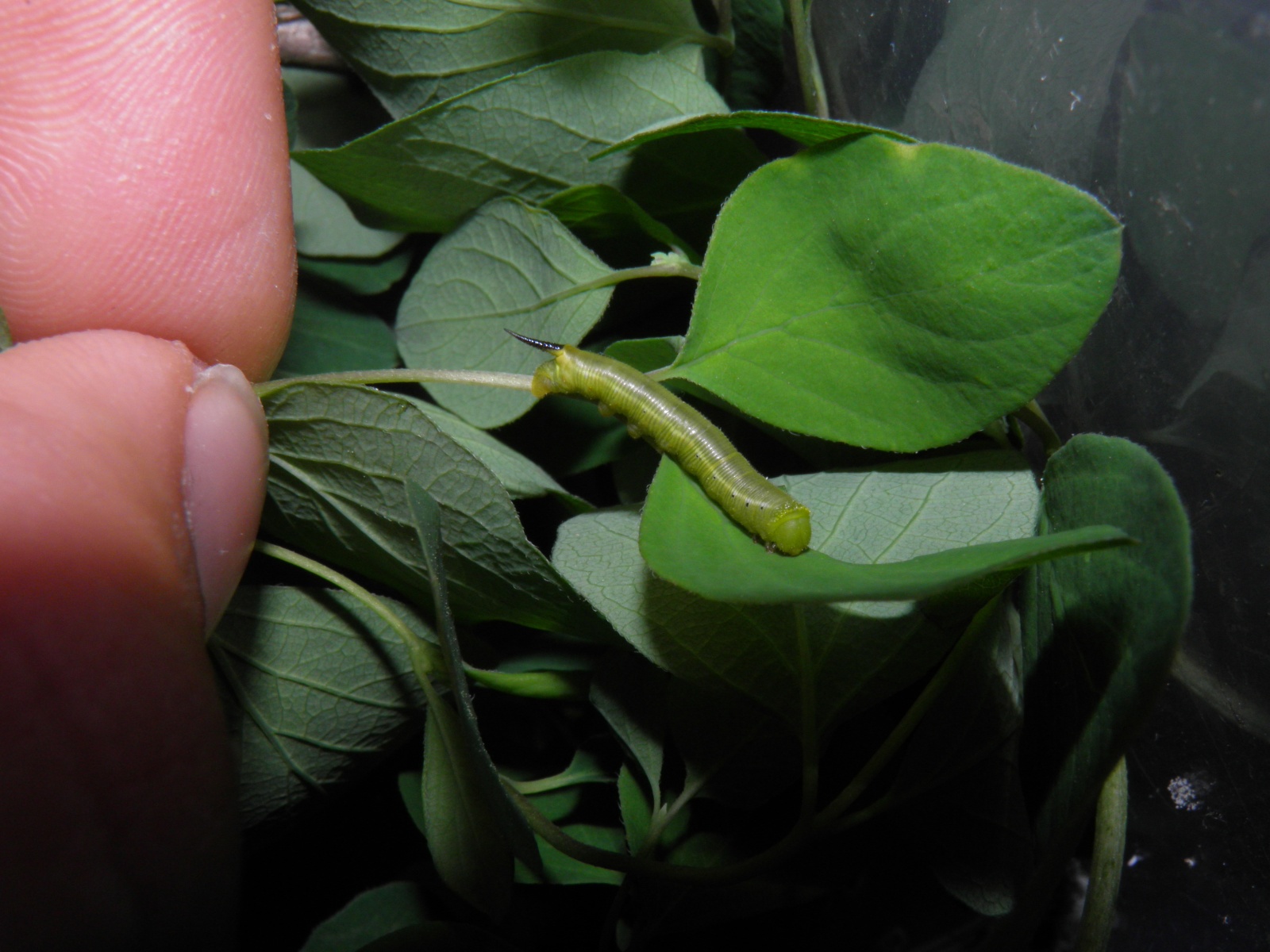 Cephonodes hylas fourth instar (L4)
Cephonodes hylas fourth instar (L4)
The caterpillars of Cephonodes hylas can grow very fast, and can be raised from egg to fully grown larvae in 1 to 1.5 month time depending on the temperature. If kept warm, their development will speed up exponentially, although it is a species that likes warmer conditions and their development may stall a little if raised cooler than room temperature (=18-21C).
The larvae can easily be raised in plastic boxes (L1 t/m L5) from eggs to mature larvae; they seem to be more tolerant towards a lack of airflow and ventilation than most species are, although keeping them too humid in such containers may still prove to be a potential risk of infections. Important is to keep them clean with fresh food – ventilation is optional, but makes for a less risky rearing anyways, so I would recommend it, if not just a little. Despite that, they do not become sick or infected as fast as other types of hawkmoths if raised in plastic containers. Of course, using a sleeve, bottle or potted plant works great aswell.
The colour of Cephonodes hylas larvae is extremely variable; they exihibit extensive polymorphism. This page only displays the green forms since I have only raised these forms myself; but the larvae can black, red/brown with white stripes, green with black stripes, yellow with grey stripes, black with yellow, uniformly red/yellow/green, green with blue backs and- well, you get the point. For this reason, some people may struggle to identify the larvae, especially the uncommon colour forms that are more rarely photographed, for people often try to find an exactly match in colour and shape, and this may be hard with such variable larvae.
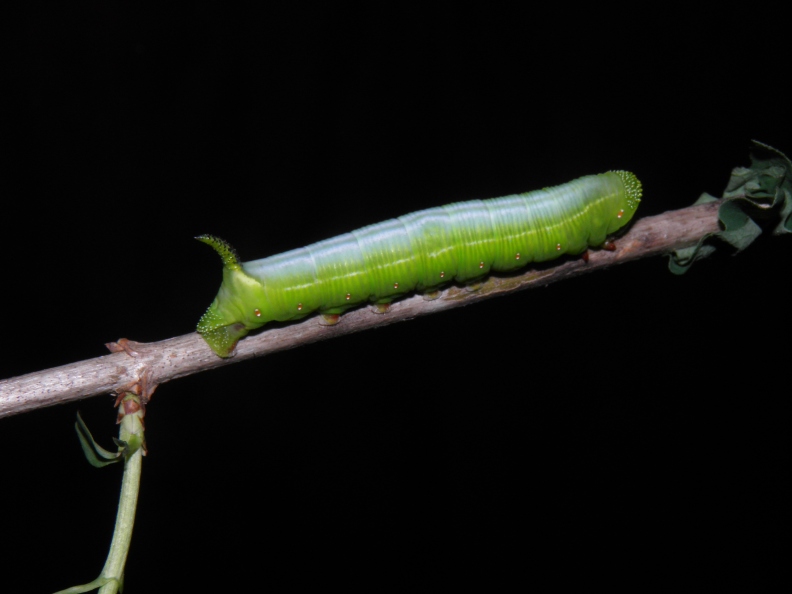 Cephonodes hylas, fully grown (L5)
Cephonodes hylas, fully grown (L5)
When they are ready to pupate, prepupal larvae get a shiny waxy look and turn dark, and start to wander and become restless. After traveling for a while they settle down in a good spot to spin a cocoon. Fully grown larvae do not burrow underground to pupate like most Sphingidae; instead, they are one of the few Sphingidae species that can spin a cocoon. However, unlike the cocoons of many types of silkmoths, the exterior of Cephonodes hylas cocoons is not just made of silk; they heavily rely on leaf litter, twigs, earth and dirt that they spin together with silk. These cocoons are produced in the foliage of the host plants, in leaf litter on the floor or in narrow crevices.
Cocoons/pupae of Cephonodes hylas can hatch very fast – in less time than a month, if kept reasonably warm (20C-25C). They are able to diapause and overwinter however. It is unclear to me if their voltinism is genetic or not, depending on subspecies and geographic origin. But it makes more sense to me that the environment regulates their generations – diapause is possibly induced by factors such as daylength, temperatures and light intensity. This means they may or may not decide to pupate depending on the conditions they have been raised in, mainly the local climate. Depending on the geographical location they seem to have one to several generations a year; it mainly depends on if the local climate allows it or not. In the tropical regions, they are most likely nearly continuously brooded, producing two to four generations in one year. The pupae, however, can overwinter, which is exactly what they do in more temperate climates, where they can survive mild to colder winters, including snowfall and frost. Pupae can be overwintered in a cool environment, ideally around 5C-10C – but shelter them from frost. A wine cellar, basement or in some cases garden shed should suffice. Provide the pupae a well insulated substrate to prevent dessication and shelter them from the harshest elements.
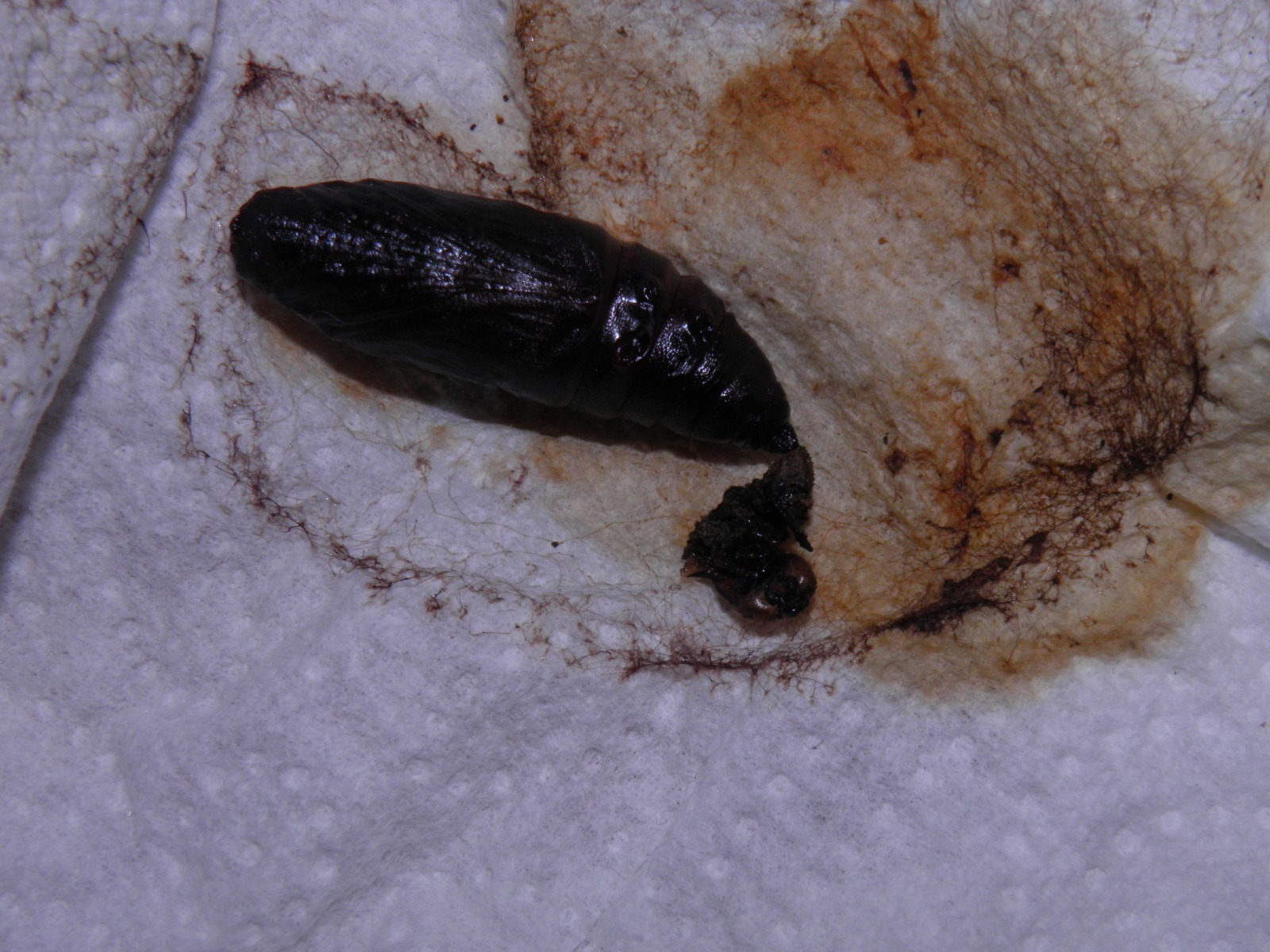 An opened ‘cocoon’ of Cephonodes hylas spun in a paper towel; the inside reveals just a few threads holding the paper together, and a pupa.
An opened ‘cocoon’ of Cephonodes hylas spun in a paper towel; the inside reveals just a few threads holding the paper together, and a pupa.
Adult moths of Cephonodes hylas can be fed a mixture of honey, sugar and water in captivity. They can be forcefed by grabbing them and putting their proboscis into the mixture, but they will also be attracted to flowers or in some cases artificial butterfly or hummingbird feeders. The moths seem to fly and reproduce well in butterfly greenhouses but also in small pop-up cages. To pair they ideally require sunlight, warmth and host plant to oviposit on, but they also seem to reproduce in subpar conditions. In some cases they have been reported to pair in small cages in captivity, even if kept in a room that does not allow much sunlight to enter. This makes them one of the less tricky Macroglossinae to pair and breed as adults.
Quite interestingly, the freshly emerged moths hatch from their cocoons with their wings covered in white scales. These scales are loosely attached to the wings, and are special type of scale that is designed to fall off when the moths take their first flight. The exact purpose of this is unknown, although it may help the moths absorb more sunlight and extra warmth with their wings when they are drying their wings after hatching, or the scales may serve some protective function. Or they could simply be an evolutionary remnant when the moths transitioned from ancestors with scaled to non-scaled wings. Personally I believe in the warmth/sunlight theory, although this has not been scientifically proven and is just speculation by the author of this website (me!).
 Cephonodes hylas, freshly hatched adult
Cephonodes hylas, freshly hatched adult
Thank you for reading my article. This is the end of this page. Below you will find some useful links to help you navigate my website better or help you find more information that you need about moths and butterflies.
Dear reader – thank you very much for visiting! Your readership is much appreciated. Are you perhaps…. (see below)
-
-
- Not done browsing yet? Then click here to return to the homepage (HOMEPAGE)
- Looking for a specific species? Then click here to see the full species list (FULL SPECIES LIST)
- Looking for general (breeding)guides and information? Then click here to see the general information (GENERAL INFORMATION)
- Interested in a certain family? Then click here to see all featured Lepidoptera families (FAMILIES)
-
Citations: Coppens, B. (2019); Written by Bart Coppens; based on a real life breeding experience [for citations in literature and publications]
Was this information helpful to you? Then please consider contributing here (more information) to keep this information free and support the future of this website. This website is completely free to use, and crowdfunded. Contributions can be made via paypal, patreon, and several other ways.
All the funds I raise online will be invested in the website; in the form of new caresheets, but also rewriting and updating the old caresheets (some are scheduled to be rewritten), my educational websites, Youtube, breeding projects, the study of moths andconservation programs.
Donate button (Liberapay; credit card and VISA accepted)
Donate button (PayPal)
![]()
Become a member of my Patreon (Patreon)
![]()
Find me on YouTube

Find me on Instagram
![]()
Join the Discord server: Click here
Join the Whatsapp server: Click here
Buy insect cocoons: Click here
Facebook: Click here



